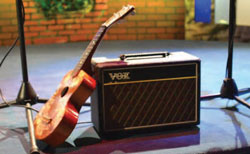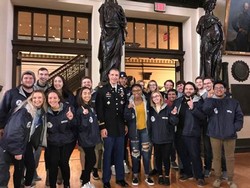Although Hurricane Sandy left miles of destruction along the shores of New Jersey, the University was fortunate enough to have minor damage.
Patti Swannack, Vice President for Administrative Services, explained that about 15 to 20 trees fell as a result of the hurricane. She continued to say, “We lost some shingles on the Alumni House, lost power for some period of time and still have some perimeter buildings that are without power but nothing critical.”
The link between Howard Hall and the Edison Science Building did have some roof penetration and damage because of the storm, according to Swannack. Therefore the solar panels had to be removed in order to fix the roof. However, Swannack said, “We were extremely lucky.”
President Paul Gaffney II reassured the community that there was no damage done to the Fountain Gardens, Pier Village apartments or the Diplomats.
The cost of the damage thus far is about $40,000, according to Swannack. This includes all of the tree work. Swannack explained that the University plans on putting a claim into Federal Emergency Management Association (FEMA). However, the claim will not only include the cost for tree damage, but also how much the University put towards making the Multipurpose Activities Center (MAC) and Boylan Gymnasium operational shelters.
“I would say our claim to FEMA will probably be well over $100,000. Which, relatively speaking, is not a lot for everything that was done here,” said Swannack. According to her, during the height of the storm, the University was sheltering about 1,050 to 1,200 evacuees.
There were no students in either of the shelters, according to Swannack. “These were people from Oceanport and Long Branch and Neptune and all over the state that had to be evacuated and had no place to go,” she said.
The students that remained on campus during Hurricane Sandy stayed in their dorm rooms. Swannack explained at one point there were about 200 students on campus but that number dropped to about 60.
Mallory Scirocco, junior, stayed on campus and felt that the University assisted students as much as they could. “The University helped by giving us heavy duty glow sticks each day and also having the Dining Hall open to charge our phones and computers,” Scirocco said.
Scirocco and her roommate Sofia Karaman remained in their dorm room in Maplewood together and had no power from Monday, October 29 to Thursday, November 1 when they got it back at around 7:30 pm. Scirocco explained that they spent a lot of time in the Dining Hall and were able to eat even though neither of them had a meal plan.
However, on the last day without power and Scirocco and her roommate went to eat at the Dining Hall, both of them had to pay for their meals. “I think the University should have kept the Dining Hall open and free to those staying on campus as long as we did not have power because we did not have a microwave or an oven to use and all of our food was going bad in the refrigerator,” Scirocco said.
President Gaffney explained that the Dining Hall was the “command center” of the University. It was running on an emergency generator that was installed a couple years ago. Because the Dining Hall had power, that is where the emails were sent from and the Facebook updates were made informing students and faculty about any new information.
A concern for Lisa Sypniewski, junior, was how the University planned on making up for missing classes. “I was in a panic when I realized how many classes I missed,” she said. “I’m just nervous that the school will be having class on Saturday to make up for lost time.”
Rumors were floating around saying that professors were going to hold class on Saturdays. President Gaffney responded to those rumors, “Saturday class? Generally no. There may be some that have to do that but generally we will not be doing that.”
However, questions were still raised about how the University was going to react regarding the time period when the school was closed. “We’re going to cancel the winter holiday,” President Gaffney said with a smile. “No, we’re trusting the students are going to work extra hard and they’re probably happy to be back in class after sitting at home for 11 days. We know professors are going to work extra hard to find a way to get everyone through material they need to learn and to finish the semester on time.”
He continued to say that classes will not run later into the winter holiday and students and faculty will not be returning any earlier from the winter break. However, President Gaffney added, “I say that cautiously because if we get another storm and have to close for the week, all bets are off for all of the eastern half of America.”
The date of the University reopening was pushed back several times. Swannack said, “We knew that if we brought back students that lived in the community, a lot of those areas still didn’t have power. Is it really safe to put students in a house without lights and then use candles?” She explained that the motivation behind changing the date several times was because safety was their primary concern.
According to Swannack, the President’s Cabinet and the Vice Presidents involved met everyday at 9:00 am to make final decisions for that day. “How do you say to somebody we’re open for business, get in your car and drive to campus? It’s not safe,” she said.
President Gaffney believes that classes and schedules will be able to get back to normal after Hurricane Sandy. “I have great faith in the faculty being able to work with the students to get this done,” he said.
If students, faculty or others outside of the school wish to help Hurricane Sandy victims, they can through the new program launched by the University called Monmouth Hawks Fly Together For Relief. The program aims at helping anyone who has suffered from the storm. Information about it and donations can be made onwww.monmouth.edu/relief.


